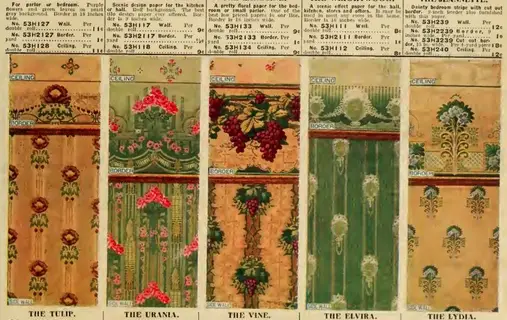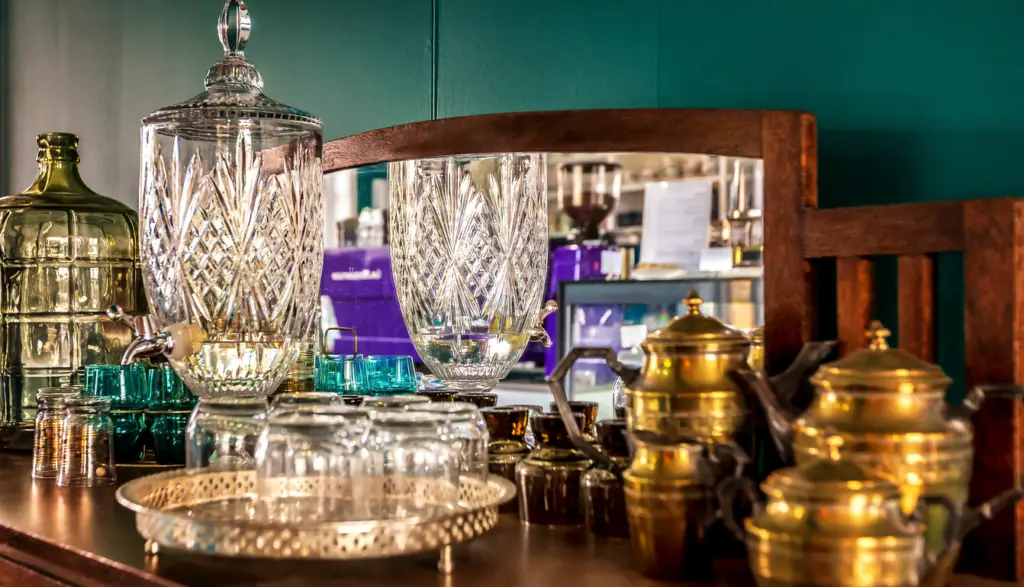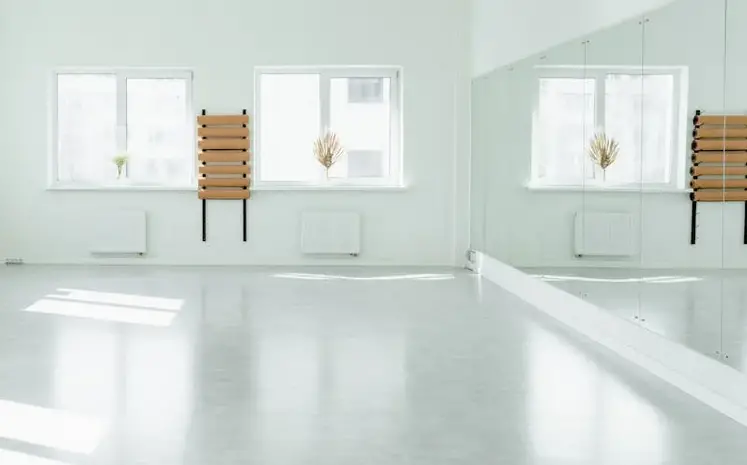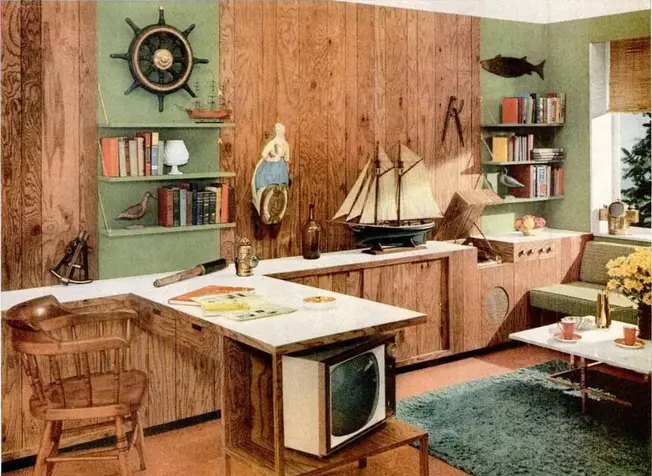Remember walking into a friend’s home in the 1980s and immediately knowing what decade you were in? Those distinctive design elements that once proudly announced “modern living” have gradually disappeared from our homes, often without us even noticing their departure. From color schemes that could wake you up faster than morning coffee to furniture innovations that seemed revolutionary at the time, these features were the backdrop to our family gatherings, weekend relaxation, and everyday lives.
1. Mauve and Dusty Blue Everything

The color palette of the 1980s home was unmistakable, with mauve and dusty blue reigning supreme in living rooms across America. These colors weren’t just accents—they dominated entire rooms, from wall-to-wall carpeting to coordinating wallpaper borders, curtains, and even bathroom fixtures. Designer showrooms and home magazines like “Better Homes and Gardens” heavily promoted these hues as sophisticated alternatives to the earth tones of the 1970s. For those who might be intimidated by this specific color assortment, Yahoo has a handful of ideas on how exactly to decorate with mauve specifically, and bring back some of the past.
By the early 1990s, these once-beloved colors began their quiet retreat from American homes, gradually replaced by more neutral tones. The pastel bathroom suite—complete with mauve or dusty blue toilets, sinks, and bathtubs—became the first target of home renovations as the millennium approached. Today, finding an original mauve bathroom suite is like discovering a time capsule, prompting either nostalgic sighs or immediate remodeling plans depending on the homeowner’s sentiments.
2. Glass Block Walls and Windows

Nothing said “upscale 1980s modern” quite like a glass block wall or window installation, bringing that Miami Vice aesthetic right into suburban homes. These translucent blocks promised the perfect combination of natural light and privacy, becoming particularly popular in bathrooms, entryways, and as room dividers in open-concept renovations. The trend reached its peak around 1987, with home improvement stores offering DIY glass block kits and installation seminars for ambitious homeowners. Quality Glass Block is also proud to share some of the diverse reasons this trend is still popping up to this day.
As minimalism and cleaner lines gained favor in the 1990s, glass blocks began to lose their appeal, with architects and designers dismissing them as bulky and dated. What once represented the height of contemporary design became shorthand for “needs updating” in real estate listings by the early 2000s. Though some glass block installations survive today—particularly in bathroom windows where privacy remains a concern—they’re more likely to prompt a renovation plan than admiration from younger homebuyers.
3. Wallpaper Borders

The wallpaper border might just be the most quintessential 1980s home feature, adorning kitchens, bedrooms, and bathrooms with country geese, floral patterns, or geometric designs. These strips of decorative paper were meant to add visual interest without the commitment of full wallpaper, creating a “finished” look that defined middle-class home décor throughout the decade. DIY wallpaper border installation became a weekend project for countless homeowners after being popularized in magazines like “Country Living” and TV shows such as “This Old House.” Good Housekeeping lists elaborate wallpaper as one of the many ’80s trends that seem to be enjoying a comeback these days, so break out those scrapers and lay out some drop cloths.
The labor-intensive removal process ultimately contributed to the border’s demise, as frustrated homeowners discovered the stubborn adhesive and damaged drywall beneath these once-cherished decorative elements. Interior designers began advocating for cleaner, simpler wall treatments in the late 1990s, and by the early 2000s, wallpaper borders had become one of the first things to go in home renovations. What was once available in endless varieties at every home improvement store has now been relegated to clearance bins and vintage home décor websites.
4. Brass Everything

Shiny brass fixtures, hardware, and accessories dominated 1980s home design, from doorknobs and cabinet pulls to bathroom faucets and lighting fixtures. This gleaming, golden-hued metal represented luxury and sophistication, appearing in manufacturer catalogs and showrooms as the premium finish option for discerning homeowners. Leading furniture companies like Ethan Allen and Thomasville incorporated brass accents into their most expensive collections, cementing its status as the finish of choice.
The brass obsession extended beyond functional items to purely decorative elements like swan-shaped bathroom faucets, ornate chandeliers, and the ubiquitous brass-and-glass coffee table that anchored countless living rooms. By the mid-1990s, however, brushed nickel and stainless steel began their ascendancy, with interior design magazines declaring brass “dated” and “excessive.” Today, while brass has made a limited comeback in more modern forms, the highly polished, ornate brass fixtures that characterized 1980s homes have largely disappeared, replaced during countless weekend DIY projects with more contemporary finishes.
5. Wall-to-Wall Carpeting

In the 1980s, hardwood floors were something to cover up, not show off, with plush wall-to-wall carpeting extending into every possible room—including bathrooms and kitchens. Carpeting represented comfort, warmth, and sound absorption, with deeper pile indicating higher quality and greater luxury in the home. The Carpet and Rug Institute reported that wall-to-wall carpet installations reached their historic peak in 1986, with over 72% of American homes featuring carpeting as their primary flooring.
Color choices often reflected the aforementioned mauve and blue palette, though beiges and “greige” options provided neutral alternatives for more conservative decorators. The discovery of carpet’s tendency to harbor allergens, combined with the reclaimed wood movement of the early 2000s, led to its gradual replacement with hardwood, laminate, and tile flooring. Today, carpet remains primarily in bedrooms, while the kitchen or bathroom carpet—once a symbol of luxury—has become an immediate red flag in real estate listings, typically mentioned alongside phrases like “original owner” or “needs updating.”
6. Mirrored Walls

Nothing amplified the glamour of a 1980s living or dining room quite like a wall covered entirely in mirrors, reflecting light and making spaces appear larger. This feature, borrowed from commercial design in restaurants and retail spaces, became a residential status symbol following its appearance in popular shows like “Dynasty” and “Dallas,” where it conveyed wealth and sophistication. Installation companies specializing in residential mirror walls emerged across suburban America, promising to bring Hollywood glamour to middle-class homes.
The practical drawbacks of mirrored walls—including constant cleaning needs and the startling effect of seeing oneself from unexpected angles—contributed to their eventual decline. Design magazines began criticizing mirrored walls as “cold” and “excessive” by the mid-1990s, suggesting warmer wall treatments that felt more intimate and homey. Today, the mirrored wall survives primarily in dance studios and gym settings, while their residential installations have been covered over with drywall or replaced with more modest decorative mirrors in the vast majority of American homes.
7. Hunter Green and Burgundy Accents

As mauve and blue began their decline in the late 1980s, they were replaced by the equally distinctive palette of hunter green and burgundy that would dominate homes through the early 1990s. This color combination appeared everywhere from sofas and armchairs to kitchen canisters, bath towels, and the ubiquitous plaid patterns that defined “country” decorating styles. Major retailers like JCPenney and Sears dedicated entire sections of their home departments to coordinating items in these rich, saturated colors.
The hunter green and burgundy era coincided with the popularity of faux Colonial and country styles, often accompanied by duck and apple motifs in kitchens and pine furniture throughout the home. This color scheme proved particularly persistent in formal dining rooms, where burgundy damask drapes and hunter green chair cushions continued to appear well into the 2000s. Today, these once-dominant colors have largely disappeared from mainstream home décor, replaced by the grays, whites, and more neutral palettes that have defined the last decade of interior design.
8. Waterbeds

Perhaps no single furniture item symbolizes 1980s home life quite like the waterbed, which reached its peak popularity midway through the decade when approximately one in five American mattress purchases was a waterbed. These undulating sleep surfaces promised improved comfort, better sleep, and a touch of adult sophistication that appealed to a generation reaching their peak earning years. Specialty stores dedicated solely to waterbed sales and accessories opened in shopping malls nationwide, offering models with built-in headboards, waveless technology, and temperature controls.
The practical realities of waterbed ownership—including difficult installation, risk of leaks, and the near-impossibility of moving them without draining—eventually contributed to their downfall. By the early 1990s, conventional mattress companies had incorporated many comfort features that waterbeds had pioneered, without the maintenance headaches. Finding a waterbed in a contemporary home is now exceedingly rare, though vintage advertising and the occasional reference in 80s-set television shows preserve their memory as one of the decade’s most distinctive domestic features.
9. Wood Paneling

Dark wood paneling transformed countless basements, dens, and family rooms into what we now recognize as quintessentially 1980s spaces, creating a masculine, den-like atmosphere that contrasted with more feminine decorative elements elsewhere in the home. Initially popular in the 1970s, wood paneling (often actually wood-patterned veneer) continued its dominance through the mid-1980s, with manufacturers like Georgia-Pacific producing millions of sheets annually for home construction and renovation. DIY installation guides regularly appeared in home improvement magazines, promoting paneling as an affordable way to finish spaces without the complexity of drywall.
The dark, cave-like effect of wood-paneled rooms eventually fell out of favor as natural light and airiness became more valued in home design toward the 1990s. Painting over wood paneling became one of the most commonly recommended home improvement projects in the early 2000s, with white or light colors instantly modernizing older homes. Today, wood paneling is primarily found in homes that haven’t been updated in decades, though limited appreciation for its vintage appeal has emerged among certain design enthusiasts celebrating “grandpa chic.”
10. Conversation Pits

The sunken living room or “conversation pit” represented the ultimate in sophisticated entertaining spaces throughout the 1970s and into the 1980s. These architectural features—essentially living areas set several steps below the surrounding floor level—created intimate gathering spots centered around massive stone fireplaces or bulky console televisions. Architectural Digest featured numerous conversation pits in high-end home spreads throughout the early 1980s, influencing custom home builders across the country.
The practical limitations of these design features—including accessibility concerns, inflexibility for furniture arrangement, and safety issues for young children and older adults—eventually led to their disappearance from new construction. Existing conversation pits were frequently filled in during renovations throughout the 1990s and 2000s, creating level floors more suitable for evolving furniture needs and open-concept living. While occasional revival interest appears in architectural magazines, the genuine 1980s conversation pit remains primarily in preserved period homes and nostalgic media representations of the era.
11. Track Lighting

Track lighting systems revolutionized 1980s home illumination, giving homeowners unprecedented flexibility to direct light exactly where they wanted it. These adjustable fixtures—typically mounted on straight or curved metal tracks attached to the ceiling—became the hallmark of modern kitchen renovations and fashionable living spaces throughout the decade. Home improvement television programs like “This Old House” frequently featured track lighting installations, while lighting manufacturers like Progress Lighting and Lightolier promoted their versatility through glossy spreads in home magazines.
The chunky profile and utilitarian appearance of early track lighting systems gradually fell out of favor as more streamlined alternatives emerged in the late 1990s. Recessed can lights and later LED fixtures offered similar directional lighting capabilities with less visual intrusion, making the once-innovative tracks seem dated and clunky. While modern versions of track lighting continue to be sold, the distinctive large-headed, industrial-looking fixtures that dominated 1980s kitchens, galleries, and living rooms have largely disappeared, replaced by more architecturally integrated lighting solutions.
12. Vertical Blinds

No sliding glass door or picture window in the 1980s was complete without its crown of vertical blinds—those long, hanging plastic or fabric slats that could be rotated for privacy or light control. These window treatments represented the height of contemporary window fashion, appearing in furniture showrooms and model homes as the sophisticated alternative to traditional curtains or horizontal blinds. Major manufacturers like Levolor and Bali promoted vertical blinds as both practical and stylish, with custom color options to coordinate with the prevalent mauve and blue décor schemes.
The practical drawbacks of vertical blinds—including their tendency to become tangled, broken slats that proved difficult to replace, and the distinctive clacking noise they made when disturbed by air conditioning or passing movement—eventually led to their decline. By the early 2000s, interior designers began recommending simpler window treatments like Roman shades or floor-length curtain panels as more elegant alternatives. Today, vertical blinds are increasingly rare in stylish homes, though they persist in rental properties and commercial spaces where their utilitarian function outweighs their dated aesthetic.
The 1980s home, with all its distinctive features and bold design choices, has largely faded into history—preserved mainly in vintage photographs, period films, and the occasional unrenovated property. As we’ve replaced mauve toilets with white ones and swapped brass chandeliers for pendant lighting, we’ve gradually erased the visual language of an entire era of domestic life. Perhaps in another thirty years, today’s farmhouse sinks and gray wood floors will seem equally dated—proof that home design, like fashion and technology, continues its endless cycle of innovation, popularity, and eventual obsolescence.


